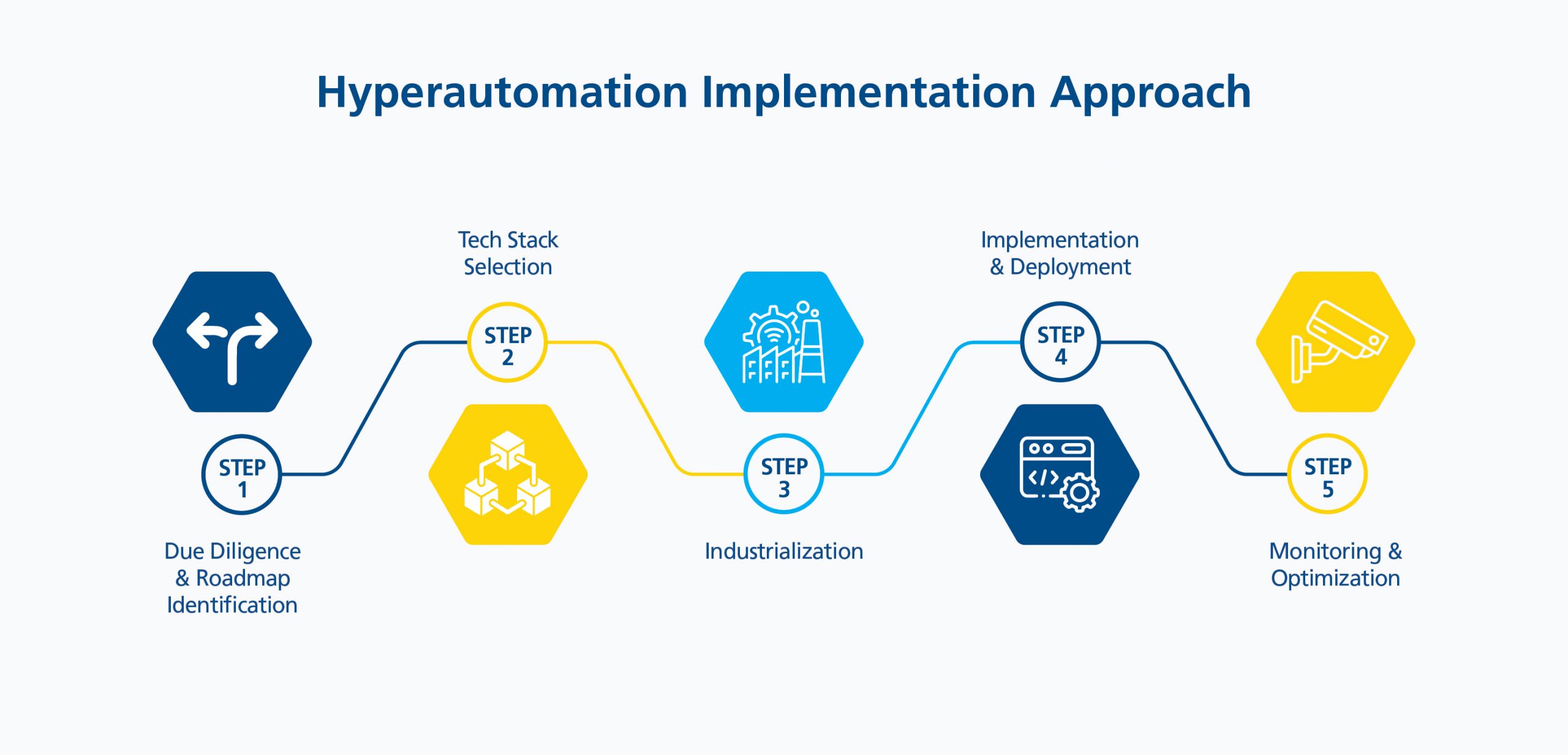Unlocking the Future of Digital Transformation with Hyperautomation Solution
Introduction
Automation is a critical enabler of digital transformation for any organization, regardless of size or sector. Today, every IT organization seeks to harness intelligent and adaptive technologies to automate routine and predictable tasks. Previously, Robotic Process Automation (RPA) platforms were used to automate data-driven decisions and interaction tasks. The current focus is on achieving end-to-end process automation across the enterprise with minimal human intervention.
However, they have failed to address enterprise-side complexities arising due to a proliferation of multiple automation initiatives. Lately, they have realized the need to introduce frameworks and methodologies to solve certain limitations, like:
- Identifying the right business processes to automate
- Automate multiple complex processes requiring cognitive decisions in parallel
- Process unstructured data input, such as images, free text, and binary data
- Leverage transient and interpreted data for intelligent enterprise transformation through autonomous data processing
“Hyperautomation” has emerged to address these limitations and priorities. The idea has occurred because of the union of automation and digital technologies like generative AI, advanced analytics, and event-driven architecture. Hyperautomation aims to make processes more efficient and cost-effective by automating them and augmenting human decision-making with automated systems. The comprehensive suite of tools and technologies offered by these solutions can assist organizations in achieving their objectives.
According to Gartner by the conclusion of 2023, organizations are expected to automate an additional 25% of tasks. If enterprises use hyperautomation solutions with reworked operational procedures, they can reduce operating expenses by 30% in the following year.
The advent of hyperautomation will affect every industry, and thus, every business must create a plan to tackle this new reality. This applies to the IT industry, which must adapt the changes brought by hyperautomation, including impact on relationships and stability.
Do IT organizations need hyperautomation solutions?
IT is a complex and dynamic industry that requires organizations to be agile, adaptive, and adjust to meet the changing business needs and expectations. Despite automation, IT organizations still face inefficiency and inconsistency in manual and siloed processes. IT delivery can be hindered by errors, delays, and rework caused by manual processes. Siloed processes are disconnected from each other, which can create gaps, redundancies, and conflicts in the delivery lifecycle. These can increase costs, reduce customer satisfaction, and lower competitive advantage.
Hyperautomation solutions can improve the quality and speed of delivery by eliminating errors, delays, and rework caused by manual and siloed processes. By leveraging process mining to analyze and model processes, hyperautomation solutions can identify tasks and events that can be automated. This can enhance IT delivery agility and scalability using automated decision-making tools for defining, executing, monitoring, and improving business processes. They can also enable faster adaptation and optimization of processes based on changing business needs and expectations.
These solutions can also reduce the costs and risks of IT delivery. It can be done by combining technologies such as Artificial Intelligence (AI), Event Driven Architecture (EDA), and Natural Language Processing (NLP). These technologies help to prioritize events, map dependencies, and sequence actions, optimizing resource use and minimizing human intervention. Using AI and RPA platforms can enhance IT delivery, providing consistent, reliable, and personalized solutions that improve customer satisfaction and loyalty.
How to successfully implement and scale hyperautomation?
Hyperautomation is a continuous process that requires a clear vision, robust strategy, and collaborative culture. Organizations face challenges when employing hyperautomation in delivery, such as scaling it and making it sustainable over time. Most organizations struggle to implement their automation initiative at an enterprise level and limit it to a select few processes. As a result, they need a systematic approach that can continuously provide consistent and sustainable benefits.

Figure 1 ─ Steps to implement hyperautomation
Step 1 ─ Due diligence and roadmap identification
The first step in this systematic approach is identifying and prioritizing automation opportunities across IT processes. Organizations must thoroughly analyze the existing delivery structure, performance, challenges, and improvement areas. After due diligence, they must identify the roadmap to ensure standardized development, deployment, and maintenance of tools and solutions. This can include using RPA platforms to automate repetitive tasks and processes. RPA platforms can help organizations scale their automation efforts and make them sustainable over time. These platforms provide tools and technologies to automate enterprise tasks and processes.
Step 2 ─ Technology stack selection
The second step will be choosing the right cluster of the technology stack that suits your automation needs. It is essential to consider the desired level and scope of automation when selecting a technology stack for hyperautomation. For instance, organizations can leverage process mining tools to visualize and analyze IT processes, identifying opportunities for automation based on frequency, complexity, variability, and impact. Similarly, they can use a combination of AI with RPA platforms and business process automation (BPA) to automate repetitive tasks that involve structured data and rules. They can also leverage this combination to learn from data, make decisions, and interact with different systems.
Step 3 – Industrialization
The third step will be the industrialization of hyperautomation solutions. The designed solution must align with business goals and requirements and co-exist with existing legacy systems. The hybrid organizational model should combine talented professionals from both business and analytics sides to form agile teams.
Step 4 – Implementation and deployment
The fourth step will be implementing and deploying the solution while being cost-effective. After the solution is developed, organizations must perform acceptance testing. They should also conduct an in-depth review of the hyperautomation pipeline before signing off for deployment in the production environment.
Step 5 – Monitoring and optimization
The fifth step is monitoring and optimizing deployed hyperautomation solutions. Organizations must perform real-time monitoring for a hassle-free hyperautomated experience. They need to measure the performance and impact of the solutions using key metrics such as efficiency, quality, cost, customer satisfaction, etc. Organizations should actively seek feedback from users and stakeholders to improve.
Conclusion
Hyperautomation is not a one-time project but a continuous journey that requires ongoing evaluation, improvement, and adaptation. Organizations need to adopt a culture of automation that encourages collaboration, experimentation, learning, and feedback. They must also keep a close eye on emerging trends like generative AI that can shape the future of automation. We are in the infancy stage of hyperautomation, with organizations exploring the possible use cases across the verticals.
More from Bharat Trivedi
Latest Blogs
Core banking platforms like Temenos Transact, FIS® Systematics, Fiserv DNA, Thought Machine,…
We are at a turning point for healthcare. The complexity of healthcare systems, strict regulations,…
Clinical trials evaluate the efficacy and safety of a new drug before it comes into the market.…
Introduction In the upstream oil and gas industry, drilling each well is a high-cost, high-risk…




